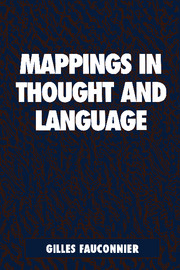4 - Analogical Counterfactuals
Published online by Cambridge University Press: 05 June 2012
Summary
How does language tie in with reasoning? One reasonable and fairly widespread view is that sentences yield meanings and that such meanings can serve as input to higher-level forms of reasoning like deduction, induction, and analogy. Under that view, the important function of language is to provide information that can be exploited by the reasoning processes, for example premises for a deductive argument or the specification of a structure that will be used analogically.
Research in cognitive linguistics supports a different conception. Language is actively involved in setting up construals, mappings between domains, and discourse configurations, with the fundamental properties of Accessing, Spreading, and Viewpoint. The formal properties that we find at the most basic semantic/pragmatic level of meaning construction are the same as the ones found in general reasoning, narrative structure, and other high-level forms of thinking and communication. The mental operations that allow us to construct meanings for the simple-looking words and sentences of our everyday life are the same ones at work in what we recognize more consciously as creative thought and expression.
A clear example of the hidden unity of micro- and macro-meaning construction processes can be found in counterfactual phenomena. The importance of such phenomena has long been recognized. To quote from Nelson Goodman's seminal article written in 1947: “The analysis of counterfactual conditionals is no fussy little grammatical exercise. Indeed, if we lack the means for interpreting counterfactual conditionals, we can hardly claim to have any adequate philosophy of science.”
- Type
- Chapter
- Information
- Mappings in Thought and Language , pp. 99 - 130Publisher: Cambridge University PressPrint publication year: 1997
- 1
- Cited by



